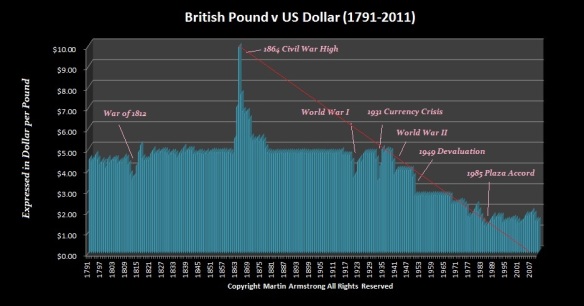This article explains how a seemly invincible empire (such as the current US empire and the past British and Hittite empires) can be suddenly militarially defeated by a weaker adversary.
The role of the US military in the downfall of American empire, and the suggestion I propose to offer is that one of the most likely triggers for an American imperial collapse is the experience of dramatic military defeat. I’m not suggesting, furthermore, that such an experience will happen in spite of the immense power of today’s US military machine; I’m suggesting that it will almost certainly happen because of that vast preponderance of force.
Chariots and battleships are simply two examples of a common theme in military history: any military technology that becomes central to a nation’s way of war attracts a constituency—a group that includes officers who have made their careers commanding that technology, commercial interests who have made their money building and servicing that technology, and anyone else who has an economic or personal stake in the technology—and that constituency will defend their preferred technology against the competition until and unless repeated military defeat makes its abandonment inescapable. One weapon such constituencies routinely wield is the military scenario that assumes that the enemy must always make war in whatever way will bring out their preferred technology’s strengths, and never exploit its weaknesses.
As far as I know, whatever literature ancient Egyptian chariot officers, horse breeders, and bow manufacturers may have churned out to glorify chariot warfare to the Egyptian reading public has not survived, but there’s an ample supply of books and articles from British presses between 1875 or so and the Second World War, praising the Royal Navy’s invincible battleships as the inevitable linchpin of British victory. All this literature was produced to bolster the case for building and maintaining plenty of battleships, which was to the great advantage of naval officers, marine architects, and everyone else whose careers depended on plenty of battleships. The fact that all this investment in battleships was a spectacular waste of money that might actually have done some good elsewhere did not register until it was too late to save the British Empire.
If my readers have any doubt that the same sort of literature is currently being churned out by the constituencies of today’s popular Pentagon weapons systems, I encourage them to visit the nearest public library and check out a copy of Tom Clancy’s 1999 puff piece Carrier: A Guided Tour of an Aircraft Carrier. It’s a 348-page sales brochure for the most elaborate piece of military technology ever built, a modern nuclear aircraft carrier, which currently fills the same role in the US military that the battleship filled in that of imperial Britain. You needn’t expect to find substantive analysis of the strengths and weaknesses of this hugely expensive technology, or of the global military strategy or the suite of tactics that give it its context; again, this is a sales brochure, and it’s meant to sell carriers—or, more precisely, continued funding for carriers—to that fraction of the American people that concerns itself sufficiently with military affairs to write the occasional letter to its congresscritters.
The inevitable military scenario comes in the last chapter, where Clancy demonstrates conclusively that if a hopelessly outgunned and outclassed Third World nation were ever to launch a conventional naval attack against a US carrier group, the carrier group will probably be able to figure out some way to win. It would be a masterpiece of unintended comedy, if it weren’t for the looming shadow of all those other books before it, singing the praises of past military technologies whose many advantages didn’t turn out to include any part in winning or even surviving the next war. Nor are carriers the only currently popular weapons system that benefits from this sort of uncritical praise; the US military is riddled with them, and thus with a series of potentially fatal vulnerabilities that rest partly on the unmentioned weaknesses of those technologies, and partly on a series of impending changes to the context of military action that follow from points we’ve discussed here many times already.
The US military faces at least three existential threats in the decades immediately ahead:
- The first is that rising powers will devise ways to monkeywrench the baroque complexity of the US military machine, leaving that machine as crippled and vulnerable as Hittite chariots were before the javelins of the Sea Peoples.
- The second is that an ongoing revolution in military affairs will leave the entire massive arsenal of the US military as beside the point as all those British battleships were once the Second World War rolled around.
- The third is that the decline in fossil fuel supplies will make it impossible for the United States to maintain a way of war that, reduced to its simplest terms, consists of burning more petroleum than the other guy.
I’ve commented before that nothing seems so permanent as an empire on the verge of its final collapse, or as invulnerable as an army on the eve of total defeat. That’s a good general rule, but it’s even more crucial to keep in mind in thinking about military affairs. The history of war is full of cases in which the stronger side—the side with the largest forces, the strongest alliances, the most advanced military technology—was crushed by a technically weaker rival. That unexpected outcome can take place in many different ways, but all of them are a function of one simple and rarely remembered fact: military power is never a single uncomplicated variable.
More at original article


